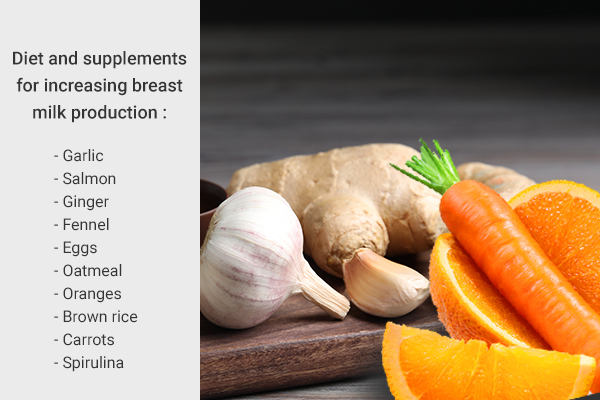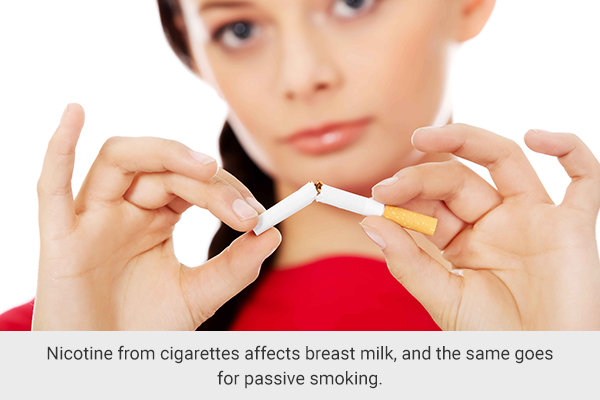In this article:
Many new mothers are worried that they might not be able to produce enough milk for their baby to breastfeed. This fear often leads to new mothers partially stopping breastfeeding within the first few months. Some may even quit completely.

If you’re worried that you may not be able to produce enough milk for your newborn, you’re not alone. The good news is there are various ways you can increase your breast milk production.
Tips for Increasing Breast Milk Production
Here are some ways to help you increase breast milk production.
1. Increase the frequency of feeding
The more you breastfeed, the better. When your baby suckles on your nipple, a hormone called prolactin is released in your body, which initiates the production and release of breast milk. (1)
It is suggested that you breastfeed your newborn at least 10 times a day for your body to establish and maintain breast milk production for your newborn. However, this is only an average number; more or fewer than this is still okay.
2. Consume the right diet and supplements

A lot of food options and herbs may be helpful in increasing milk production in women, although they may take up to a week or more to show results. These foods include: (2)
- Garlic
- Salmon
- Ginger
- Fennel
- Eggs
- Oatmeal
- Oranges
- Brown rice
- Carrots
- Spirulina
Some ingredients that contain compounds called galactagogues have been linked to increased lactation. However, the research on this is quite limited.
These ingredients include: (3)
- Whole oats
- Brewer’s yeast
- Flaxseeds
- Sesame seeds
3. Alternate the breasts

It is important that, whenever you breastfeed, you alternate between both breasts and make sure your child feeds from both breasts equally. Let them feed from one breast until they slow down or stop, and then have them feed from the second one.
If both your breasts are stimulated, milk production increases. This also increases the production of milk that has a higher fat content. (4)
4. Use a pump
Breast pumps are now available that mothers can use between rounds of breastfeeding. Pumping has been shown to increase milk production and also make the mother feel more comfortable while making breastfeeding easier. (5)
You can pump when you still have milk even after feeding or when your baby completely misses a feeding. Also, you can pump if your baby is on formula or fed using a bottle.
5. Reduce stress levels
A common reason for low breast milk can simply be stress. Any kind of emotional distress including anxiety, a feeling of embarrassment, or depression can interfere with healthy milk production.
So, breastfeeding in a strain-free, stress-free environment can help you increase your milk production. (6) Moreover, it is important for mothers to get enough sleep.
6. Resolve health issues
Some health conditions interfere with milk production. These include: (7)(8)
- Hypertension
- Diabetes
- Polycystic ovarian disease (PCOD)
- Hormonal disorders
- Obesity
- Hepatitis B or C
- Herpes
Resolving these health issues via proper treatment and ensuring their thorough management is another way to maintain healthy milk production.
7. Go through your medicines
Medications that some mothers may take regularly such as anti-allergies or birth control may also hinder breast milk production.
So, if you’re unable to see what is causing your low milk production, talk to your doctor about all the medications you’re taking to make sure none of them interfere with your milk production. (9)
8. Avoid smoking

Smoking is known to transfer harmful chemicals to the baby via breast milk. Not only this, but it also negatively affects mothers’ milk supply.
The nicotine from cigarettes affects breast milk, and the same goes for passive smoking. It can give your baby chest infections, diarrhea, and other health issues.
So, to ensure that you produce sufficient and healthy breast milk, avoiding cigarette smoke is very important. (10)
9. Massage your breast
A study suggested that circular and oscillating breast massage can be a useful technique to increase milk production and alleviate breast pain and swelling in lactating mothers.
The study group showed an increase in milk production by 7.92%, 5.25%, and 5.02% on days 1, 2, and 3 of the procedure, respectively, and a 22.28% increase in total milk production over 3 days. The differences in milk production between the study and control groups were significant. (11)
10. Observe skin-to-skin contact (kangaroo mother care)
Kangaroo mother care (KMC) is an innovative technique for caring for premature infants that involves continuous skin-to-skin contact between a mother and her baby, with the baby placed upright on the mother’s chest in what is known as the kangaroo position.
A study found that KMC is a safe, effective, and feasible method for improving breastfeeding rates. The study found a 4.1-fold increase in breastfeeding with KMC. (12)
11. Position and latch the baby correctly

Positioning and latching correctly are essential for successful and comfortable breastfeeding. The baby should be positioned in a way that allows them to have their entire body facing the mother.
Correct positioning and latching, as well as offering both breasts, can help ensure that the baby is getting enough milk. The baby’s mouth should be open wide, and the mother should bring the baby to the breast, ensuring that the baby takes in as much of the areola as possible, not just the nipple, as per gynecologists.
It is important to offer both breasts at each feeding to ensure that the baby is receiving enough milk and to stimulate milk production. Mothers should nurse their baby for at least 15 minutes at each breast and not limit nursing time.
Breast compression during feeding can also be helpful to help drain the breast and ensure the baby is getting as much milk as possible. (13)
Tips for Mothers Who Work Outside the Home
Mothers who are employed outside the home can utilize breast pumps to sustain their milk production while they are away from their babies, according to experts. It is crucial to pump breast milk regularly and at a frequency that matches the infant’s feeding schedule.
If the pumped milk is intended for use within 48 hours, it should be refrigerated immediately. Conversely, if the milk is intended for use after 48 hours, it should be frozen right away.
Refrigerated milk that remains unused beyond 96 hours should be discarded as it may have a higher risk of bacterial contamination. Thawing frozen milk should be done by placing it in warm water as microwaving is not recommended by experts. (14)
Additional Facts About Breastfeeding and Milk Production That You Must Know

To promote breastfeeding, healthcare providers should initiate conversations with expectant mothers about the many benefits of breastfeeding.
- Breastfeeding leads to improved nutrition and cognitive development for the child, as well as protection against infections, allergies, obesity, Crohn’s disease (chronic inflammatory bowel disease that affects the digestive tract), and diabetes. (15)(16)(17)
- Breastfeeding also benefits the mother, according to gynecologists, by reducing fertility during lactation, promoting faster postpartum recovery such as uterine evolution (the process of the uterus returning to its pre-pregnancy state after childbirth) and weight loss, and providing protection against osteoporosis, obesity, and ovarian and premenopausal breast cancers. (16)(17)
- Milk production is established in new mothers (primiparas) within 72–96 hours, while it takes less time in mothers who have given birth before (multiparas), according to experts. (18)
- The first milk produced is called colostrum, which is a thin, yellow fluid that is rich in antibodies, lymphocytes, and macrophages. Colostrum is high in calories and protein, and it provides important immune protection to the newborn. Colostrum also helps to stimulate the baby’s passage of meconium, the first stool. (16)
When Should a Mother Worry About Insufficient Breast Milk Production?
Here are some conditions that may require a doctor’s consultation:
- If a mother has HIV and is not on antiretroviral therapy (ART) or has an unsuppressed viral load during pregnancy, delivery, and postpartum, it is recommended to consult a doctor regarding breastfeeding. (19)
- If a mother is using illicit drugs such as opioids, PCP, or cocaine (unless the mother discontinues the use of such drugs or is on stable methadone or buprenorphine maintenance therapy). (20)
- If a mother has active tuberculosis that is untreated (she should not breastfeed until appropriately treated for 2 weeks and is no longer contagious). (21)
- If a mother develops active varicella (chickenpox) infection within 5 days before delivery or 2 days following delivery. (22)
Most-Asked Questions About Breastfeeding and Breast Milk Production
Why do babies get uneasy while breastfeeding?

There are quite a few reasons a baby may start crying, may become fussy, or may be unable to feed without distractions. Many of these reasons may not even be due to your milk supply.
These factors can interfere with breastfeeding:
- Teething
- Gas
- Tiredness
- Sleepiness
- Noise/light
How to know that the baby is getting enough milk?
The goal is to make sure the baby gets enough milk so that they can gain healthy weight and require a diaper change regularly to show proper metabolism. Babies should have 3–4 bowel movements every day.
What is perceived insufficient milk?
Perceived insufficient milk (PIM) refers to a breastfeeding mother’s belief or perception that she is not producing enough breast milk to adequately feed her baby.
PIM is a common reason why many women stop breastfeeding within the first few weeks after giving birth. It is estimated that about 35% of women who wean early cite PIM as their main reason for doing so.
Instead of assessing their actual milk supply, many women rely on their infant’s satisfaction cues as an indicator of milk supply, a practice that is also common among researchers and clinicians. (23)
Final Word
All babies have their own unique needs. Some may require around 10 rounds of feedings a day, while others may relax in fewer rounds. Either way is fine.
If you’re worried about your child’s nutrition status, try the various tips above to increase breast milk production. Moreover, ensuring regular baby checkups with the doctor will help in knowing if your baby is getting enough nutrition via feeding.
If your milk supply is low, you can try baby formula. You may consult a lactation specialist for more information before making a decision.
- Was this article helpful?
- YES, THANKS!NOT REALLY


